
The pomegranate is a fruit-bearing deciduous shrub in the family Lythraceae, subfamily Punicoideae, that grows between 5 and 10 m tall. The pomegranate is rich in symbolic and mythological associations in many cultures.

Australian limes are species of the plant genus Citrus that are native to Australia and Papua New Guinea.
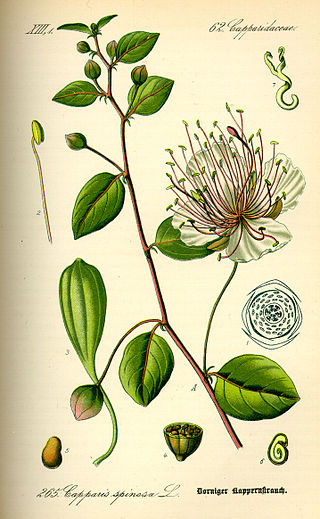
Capparis spinosa, the caper bush, also called Flinders rose, is a perennial plant that bears rounded, fleshy leaves and large white to pinkish-white flowers.

Alstroemeriaceae is a family of flowering plants, with 254 known species in four genera, almost entirely native to the Americas, from Central America to southern South America. One species of Luzuriaga occurs in New Zealand, and the genus Drymophila is endemic to south-eastern Australia.
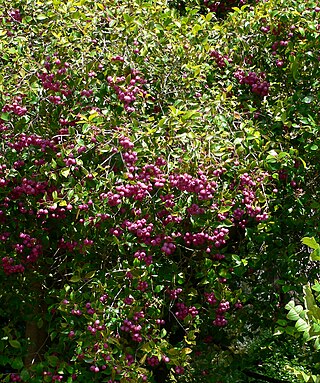
Syzygium smithii is a summer-flowering, winter-fruiting evergreen tree, native to Australia and belonging to the myrtle family Myrtaceae. It shares the common name "lilly pilly" with several other plants.It is planted as shrubs or hedgerows, and features: rough, woody bark; cream and green smooth, waxy leaves; flushes of pink new growth; and white to maroon edible berries. Unpruned, it will grow about 3–5 m (9.8–16.4 ft) tall in the garden.

Osteospermum moniliferum is an evergreen flowering shrub or small tree in the daisy family, Asteraceae. It is native to southern Africa, ranging through South Africa and Lesotho to Mozambique and Zimbabwe.

Syzygium paniculatum, the magenta lilly pilly or magenta cherry, is a species of flowering plant in the myrtle family Myrtaceae, native to New South Wales, Australia. A broad dense bushy rainforest tree, in cultivation it grows to a height of 15 m (49 ft) with a trunk diameter up to 35 cm (14 in). The largest known example is at Ourimbah Creek, 35 m (115 ft) metres tall. The leaves are 3–9 cm (1.2–3.5 in) long, opposite, simple and slightly obovate, tapering at the leaf base. They are dark glossy green above, and paler below. White flowers are produced in clusters. The edible fruit is usually magenta, but can be white, pink or purple. The seeds are polyembryonic.

The wild orange is an Australian native plant found in dry inland areas of Australia. Its scientific name is Capparis mitchellii. It is not related to oranges, nor to the Osage-orange which is known as "wild orange" in North America, but to capers.
Wild orange is a common name for several plants bearing fruit reminiscent of oranges. They are not necessarily related to family Rutaceae. Plants called wild orange include:

Capparis is a genus of flowering plants in the family Capparaceae. It includes 142 species of shrubs or lianas which are collectively known as caper shrubs or caperbushes. Capparis species occur over a wide range of habitat in the subtropical and tropical regions of Africa, Eurasia, Australasia, and the Pacific.

Ficus fraseri, the white sandpaper fig or shiny sandpaper fig, is one of several fig species commonly known as sandpaper figs. It is native to the northern and eastern coasts of Australia, and to New Caledonia and Vanuatu. Other common names are "figwood" and "watery fig".

Eustrephus is a monotypic genus in the family Asparagaceae, subfamily Lomandroideae. The sole species is Eustrephus latifolius, commonly known as wombat berry. It is an evergreen vine native to Malesia, the Pacific Islands and eastern Australia. It grows in sclerophyll forest, woodland, heathlands, shrublands, gallery forest and rainforests.
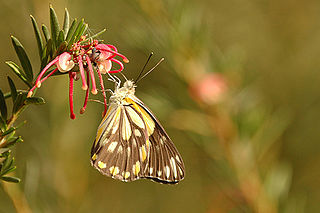
Belenois java, the caper white or common white, is a small butterfly of the family Pieridae found in Australia, Indonesia, and Melanesia. It is highly migratory and is often confused with the cabbage white.
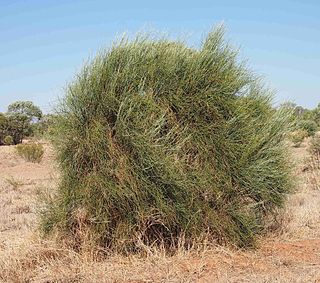
Capparis anomala is a species of flowering plant, commonly called warrior bush or broom bush, which is native to Australia.
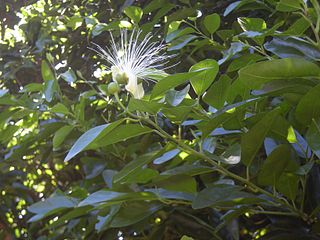
Capparis arborea is a bush or small tree occurring in eastern Australia. The habitat is rainforest; usually riverine, littoral or the drier rainforests. Distributed from the Hunter River, New South Wales to Cape Melville in tropical Queensland. Common names include native pomegranate, wild lime, wild lemon and brush caper berry.
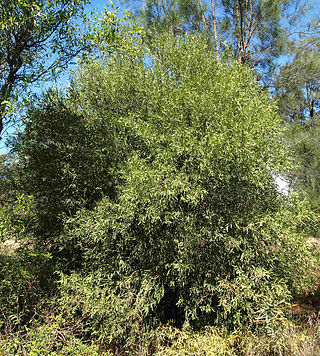
Alectryon oleifolius, commonly known as boonaree, inland rosewood or bullock bush, is a species of small tree of the soapberry family Sapindaceae, native to Australia.
Native pomegranate may refer to:

Capparis lasiantha is an endemic Australian plant with a range that extends from the Kimberley region through the Northern Territory and Queensland to northern New South Wales, primarily in drier inland areas although the species extends to the coast in Central Queensland. Common names are numerous and include wyjeelah, nepine, split jack, nipang creeper, nipan, native orange and bush caper.

Glycine canescens, common name Silky Glycine, is trailing or twining herb. It is a species of soybean native to Australia. A perennial living across the Outback in extremely hot and dry conditions, it is being studied for its potential to improve the cultivated soybean . Grows in sandy or stony soils in a variety of habitats.

Capparis loranthifolia, also known as the narrowleaf bumble or narrow-leaved bumble tree, is a shrub or small tree in the caper family. It is endemic to the arid and semi-arid interior of northern and eastern Australia from Western Australia to New South Wales.


















